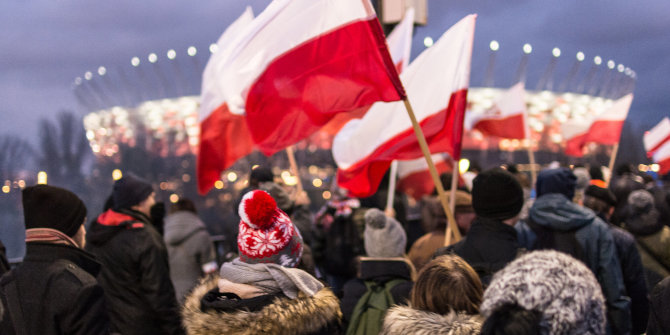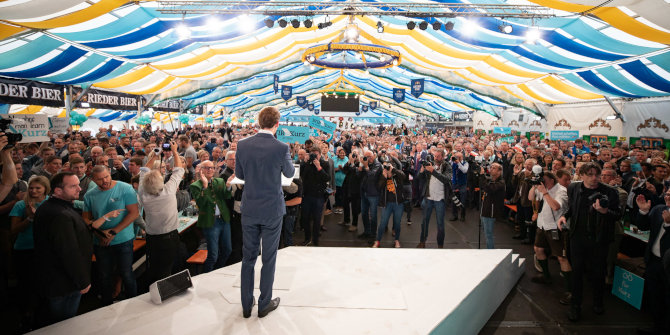 On Monday, Norway held parliamentary elections, with the Conservative Party’s Erna Solberg winning enough support to take over as the country’s next Prime Minister. Sveinung Arnesen assesses the results of the election, noting that the new centre/right coalition that emerges from negotiations will be far more diverse than previous governments. The main challenge for the new government will be keeping this coalition together over the next four years.
On Monday, Norway held parliamentary elections, with the Conservative Party’s Erna Solberg winning enough support to take over as the country’s next Prime Minister. Sveinung Arnesen assesses the results of the election, noting that the new centre/right coalition that emerges from negotiations will be far more diverse than previous governments. The main challenge for the new government will be keeping this coalition together over the next four years.
Norwegian prime minister Jens Stoltenberg drew international attention for an election campaign stunt where he pretended to be a taxi driver. Monday’s election outcome suggests he will now have time to practice his driving skills out of office. The next prime minister of Norway will be the Conservative Party’s Erna Solberg, and the populist right Progressive Party is likely to join her in government for the very first time.

In line with anticipations prior to the election campaign, the incumbent government coalition faced defeat in the 2013 Norwegian parliamentary election. Prime minister Stoltenberg charmed the public with his taxi stunt, but neither this event nor any other campaign effort would convince the voters that the centre/left government deserved an exceptional third consecutive term in office. The election campaign in general was nothing out of the ordinary, and did not produce any large net effects in either direction, perhaps with the exception that Labour during these weeks regained their position as the biggest party in the country.
It is not certain which of the four opposition parties will be part of government. A minority government is a possible, but undesirable, option. Both the Conservative Party and the Progressive Party are needed to form a three party majority coalition, but they will also need another partner to the left of them. The centrist Christian Democratic Party and the Liberal Party both have the sufficient size to form a majority in a tripartite government with the Conservatives and the Progressives.
The two centrist parties’ main problem is that either of them will suffice to form a majority. As such, they are faced with a strategic situation that resembles the classic prisoner´s dilemma scenario. Seen from the outside, the centrist parties will be strategically better off if they pair up and join in a coordinated effort to combat “divide and conquer” tactics from the other negotiating partners. If they enter the talks with an ultimatum of accepting both or none of the two parties in government, they will have a stronger position in the negotiations. Whether they are able to execute such a strategy remains to be seen.
The Progressive Party is for the first time a highly likely government coalition partner. They are perceived as a polarising party among the electorate, lastly exemplified by party leader Siv Jensen´s vindictive and frenetic “farewell message” to prime minister Stoltenberg on Election eve, as it became evident that his reign was over. Nevertheless, in Norway, the Progressives are not perceived as being quite as radical as some international press coverage tends to portray them. Over the years, the party has become more mainstream than it used to be, and its members are ready to make some major concessions in exchange for executive power.
That said, they have seen what the cost of rule has done to their counterpart on the left wing, the Socialist Left Party, which throughout their eight years in office steadily lost support and this year just marginally surpassed the 4 per cent election threshold. Too many policy compromises may lead the Progressives towards that same slippery slope. Indeed, with a vote share drop of more than six percentage points from the last election four years ago, one may argue they have already started paying the price for becoming less populist and more responsible. Hence, more than anyone they will need to balance their lust for power against staying true to the political programme their voters chose them for.
Having received a vote share clearly on the upper side of a normal election, the Conservatives are by far the biggest party in the coming centre/right coalition. Their party leader Erna Solberg´s position as future prime minister is undisputed. She is a seasoned politician with previous experience in government, and is generally regarded as a competent, resolved, yet reasonable leader. She will undoubtedly need all of her skills in trying to maintain a majority coalition for the coming four years, for the political span between the potential majority coalition partners is unprecedentedly large.
Historically, the parties on the centre/right side of the spectrum have had more difficulties in keeping together than the parties on the centre/left. To be sure, there are several policy areas where the tensions between the parties are big. This includes areas such as immigration, environmental issues, development aid, the level of spending of oil revenues, and more. However, the opposition parties have now had eight years to prepare for a government takeover, and the will to cooperate is certainly there. Behind the scenes, the parties have spent the opposition years identifying areas where they can agree on policy.
Depending on the negotiations, Norway is likely to see policy changes on classical areas from the right side of the political spectrum. These include increased privatisation in sectors like education, health, and infrastructure, as well as decreased levels of taxes on businesses and individuals. At the 2013 crossroads, the Norwegian people have taken a firm – but not sharp – turn right.
Please read our comments policy before commenting.
Note: This article gives the views of the author, and not the position of EUROPP – European Politics and Policy, nor of the London School of Economics.
Shortened URL for this post: http://bit.ly/18US58x
_________________________________
 Sveinung Arnesen – University of Bergen
Sveinung Arnesen – University of Bergen
Sveinung Arnesen is a Senior Research Fellow at the Department of Comparative Politics, University of Bergen. His research interests include electoral behaviour and election forecasting, civil society and the voluntary sector, and the legitimacy of collective decisions. You can follow Sveinung on Twitter @sveinungarnesen





Dear Mr Arnesen – thank you for a very interesting comment. I am wondering how do you asses the chances of Venstre pushing forward the moratorium over oil and gas exploitation in Lofoten and Vesteraalen? Thank you in advance for your answer.
Dear Lidia Puka,
Venstre (the Liberals) have themselves put this on the very top of the agenda in the negotiations. Given the high priority of this topic, I think it is likely that the parties may reach a deal not to exploit this area, at least not for the next four years.
Agreed. Both the Conservatives and the Progressive Party are too focused on other matters, while at the same time realizing the need to keep the two other parties on board and let’em have that which seems much more important to them. I’m actually pretty sure the Progressive party, however bold they appear to pose these days, are willing to trade away anything for a stricter immigration policy, knowing too well that this is the policy most of they voters care deepest about. If they can not have any influence on immigration, they will probably break out instead. I think the Conservatives also is willing to let the oil rest below the seabed for now in order to keep the peace. At least that’s my 50 cents. The scholars may not agree.